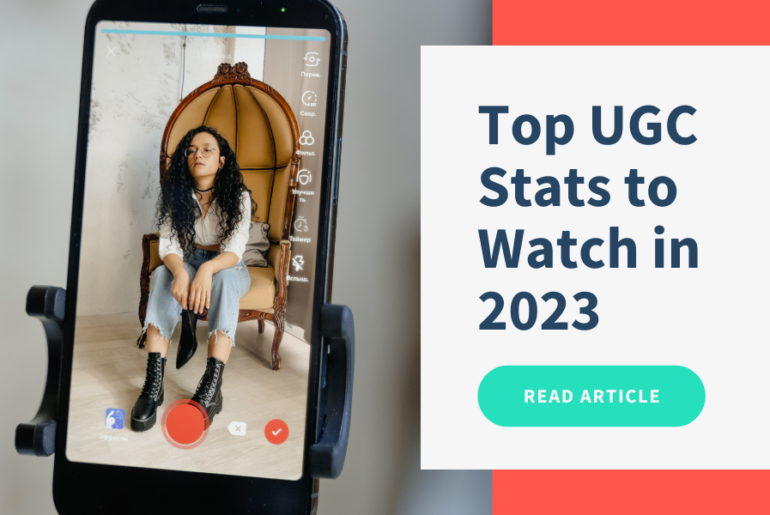When it comes to marketing effectiveness, user-generated content (UGC) steals the show. Marketers have learned that UGC is one of the best ways to build trust, grow engagement, and drive conversions, and the following stats prove it.
All marketing channels benefit from UGC, and that’s what makes it so appealing to brands. UGC is everywhere these days, all over organic social media, email content, digital advertising, websites, brand marketing, and in-person activations.
Every year, we compile a big list of the most important user-generated content marketing stats that you need to know. This year, many of them come directly from original research reported in our State of User-Generated Content report. Will UGC reign supreme again this year? And what do the numbers mean for your marketing strategy?
Here are the key stats on UGC this year and what they mean for your marketing strategy.
Key User-Generated Content Marketing Stats to Remember
- 64% of consumers agree that when a brand they like and use re-shares content by customers, they are more likely to share content about the brand or its products. (State of User-Generated Content)
- 76% of consumers have purchased a product because of someone else’s recommendation before. (State of User-Generated Content)
- 72% of consumers believe that reviews and testimonials submitted by customers are more credible than the brand talking about their products. (State of User-Generated Content)
- 62% of consumers report that they are more likely to click on content like ads, websites, social posts, or emails, that feature customer photos rather than an image created by the brand. (State of User-Generated Content)
- 60% of consumers wish that more brands would tell their fans and customers what type of content they want them to create. (State of User-Generated Content)
- 72% of users will accept a brand’s request to use their content, meaning people are excited to participate when brands ask them for rights to repurpose their content. (TINT)
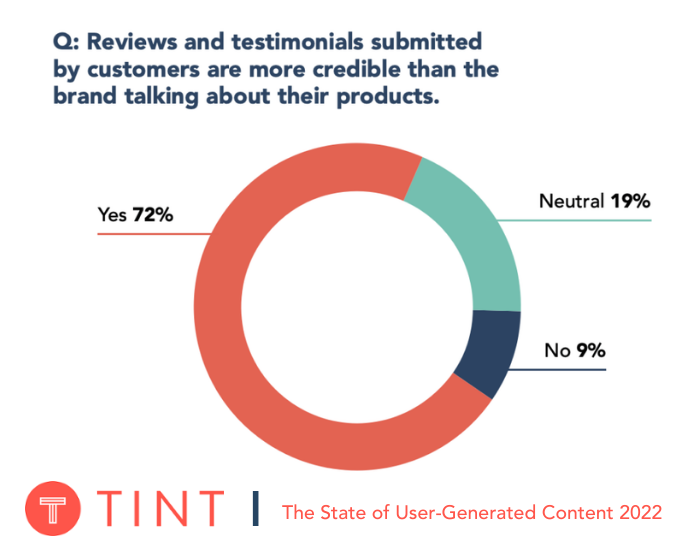
Social Media Marketing Stats
- 71% of marketers plan on increasing efforts in video content in 2022. (State of User-Generated Content)
- 64% of consumers have tagged a brand or used a hashtag on social media before. (State of User-Generated Content)
- 63% of consumers believe that visual testimonials are more credible than written testimonials. (State of User-Generated Content)
- 62% of consumers report that they are more likely to click on content like ads, websites, social posts, or emails, that feature customer photos rather than an image created by the brand. (State of User-Generated Content)
- Social media users increased by more than 13% from 2020 to 2021, with nearly a half billion new users joining. This brings the global total of social media users to 4.2 billion in early 2021.
- Consumers are nearly 3x more likely to engage with a brand’s social media content than any other type of media they create. (State of User-Generated Content)
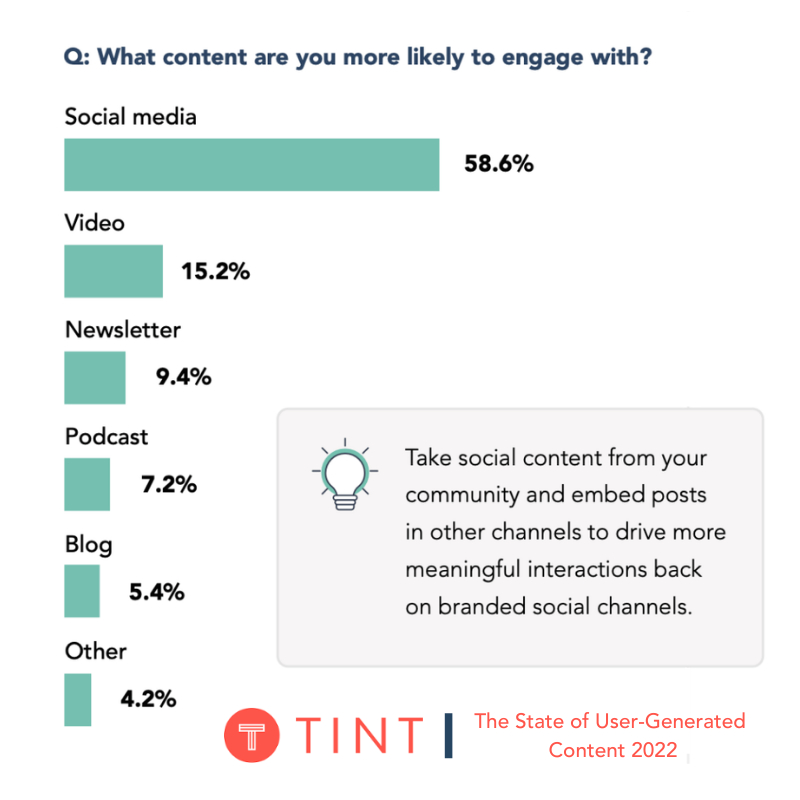
Email Content Marketing Stats
- When emails contain user-generated content, click-through rates increase by about 73% and produce more conversions.
- Consumers over the age of 45 prefer email over social media and other channels. (State of User-Generated Content)
- 4 out of 5 marketers said they’d rather give up social media than email marketing.
- 20% of retail, e-commerce, and consumer goods and services companies are personalizing emails based on gender, race, ethnicity.
- Marketers who use segmented campaigns note as much as a 760% increase in revenue.
- Social media, advertising, and email marketing are the top 4 channels marketers are using UGC today. (State of User-Generated Content)
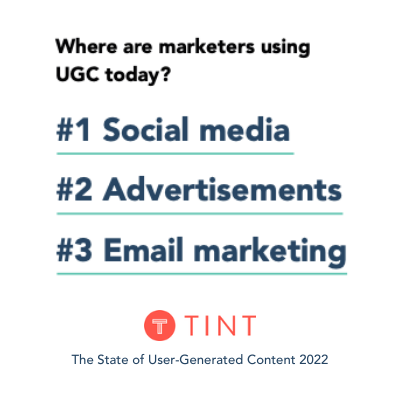
Digital Advertising
- 62% of consumers report that they are more likely to click on content like ads, websites, social posts, or emails, that feature customer photos rather than an image created by the brand. (State of User-Generated Content)
- Consumers are 4-6X more likely to buy from and advocate for “purpose-driven” companies.
- Using user-generated content in social media ads can reduce cost-per-click (CPC) by 50%.
- 6 in 10 marketers report that their audience engages more with UGC in marketing and communications channels than branded content. (State of User-Generated Content)
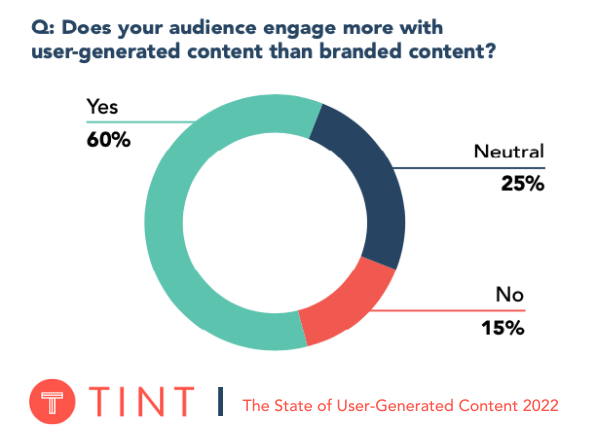
Web Content Stats
- There has been an increase of 29% in web conversions when websites featured user-generated content.
- Websites with featured user content saw a 20% increase in return visitors. Additionally, these websites recorded a 90% increase in time spent on-site.
- The number of virtual reality (VR) and augmented reality (AR) users in the United States is forecasted to reach 110 million users by 2023
- 22% of the U.S. and 15% of the U.K. Internet users think brands should advertise in the metaverse.
- 49% of marketers agree that the metaverse will impact their brand and marketing strategies in 2022. (State of User-Generated Content)
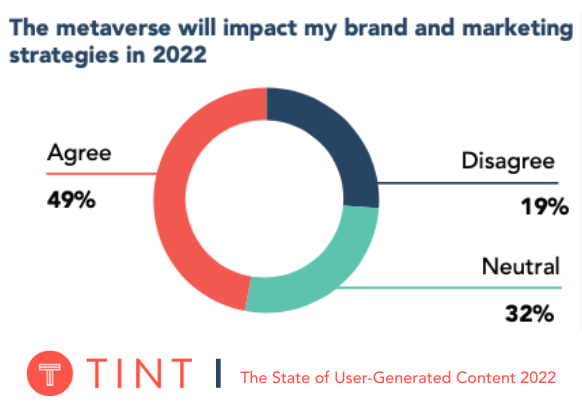
Brand Marketing Stats
- 65% of consumers agree that it’s important to them to see brands channeling diversity in their brand. (State of User-Generated Content)
- 45% of consumers agree that they would unfollow a brand due to too much self-promotion. (State of User-Generated Content)
- 78% of consumers feel that they can tell when a brand is advertising to them. (State of User-Generated Content)
- 71% of marketers plan on showing more diversity, inclusivity, and accessibility in their content in the future. (State of User-Generated Content)
- 6 in 10 marketers feel that their organization could do a better job at highlighting participation in social issues. (State of User-Generated Content)
- 19% of the U.S. and 13% of the U.K. Internet users think brands should build more branded experiences in the metaverse
- 63% of marketers plan to blend more community voice with their brand voice in 2022.(State of User-Generated Content)
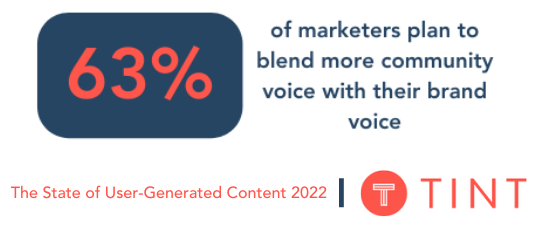
eCommerce and Social Commerce Stats
- 77% of shoppers are more likely to buy from brands that personalize their shopping experience. (State of User-Generated Content)
- 72% of consumers believe that reviews and testimonials submitted by customers are more credible than the brand talking about their products. (State of User-Generated Content)
- 76% of consumers have purchased a product because of someone else’s recommendation before. (State of User-Generated Content)
- 75% of consumers report that they are likely to search for reviews and testimonials before making a purchase. (State of User-Generated Content)
Travel, Tourism, and Hospitality Stats
Source: Content Matters as Travel Recovers: Influencing and Activating Travelers
- Three-quarters or more of travelers were active on at least one social media platform in 2019.
- The social platforms most commonly used by travelers were Facebook, Instagram, and Twitter (with the exception of Chinese users).
- Younger travelers (under 34) used Facebook as frequently, if not more, than other travelers within their markets.
- Pre-COVID, 46-85% of socially-engaged travelers used their smartphones for researching airfare, hotel rooms, vacation packages, or in-destination activities, and social content influenced their conversion rates.
- 70 – 80% of travelers also want to book travel that has flexibility when it comes to canceling or rebooking. Refunds, cancellation, and rebooking options and policies should be clear and easy to find before they move to the booking process. Even better if reviews on social or directory listings tout how easy the process was.
- About 3/4 of travelers want to be informed about safety precautions before booking, even if particular initiatives are not critical to them, such as cleaning/sanitation procedures and mask requirements.
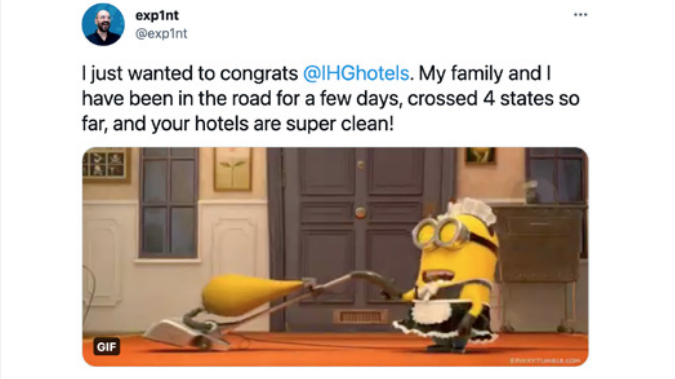
What Do These Marketing Stats Mean For Your 2022 Strategy?
Based on these marketing stats, the consumer trends shaping the market, and the marketing themes and predictions laid out in our annual research report, the numbers all point towards UGC. Marketers, you’ve got to make sure you’re using your user generated content platform to its fullest this year on all channels.
Social Media
With 4.2 billion people on social media, and it being the place where consumers are 3x more likely to engage with brands, it’s a channel you have to optimize with what consumers want. Right now, that’s video content they can trust from consumers like them.
Email
When emails contain UGC, click-through rates increase by about 73%. Segmented campaigns note as much as a 760% increase in revenue. Use UGC on segmented campaigns to hyper-personalize your recipients’ experience. It may be tedious, but clearly, it has results.
Digital Advertising
Consumers are 62% more likely to click on customer content rather than branded content and are 4-6x more likely to purchase from purpose-driven companies. Make sure to use video UGC that tells your brand’s purpose-driven stories.
Web
UGC increases time on site by 90% and conversions by 29%. Use it on your homepage, product galleries, and review sections. Make sure there’s a diverse set of people portrayed.
Brand
Bring consumers into your brand voice, brand image, and brand experiences.
Hopefully, this serves as a helpful starting point for implementing UGC into your marketing strategy. To dive even deeper, learn how TINT can help you connect with your audience better than ever before through the power of UGC. Schedule a demo to see what TINT’s all-in-one platform and UGC experts can do for you.



